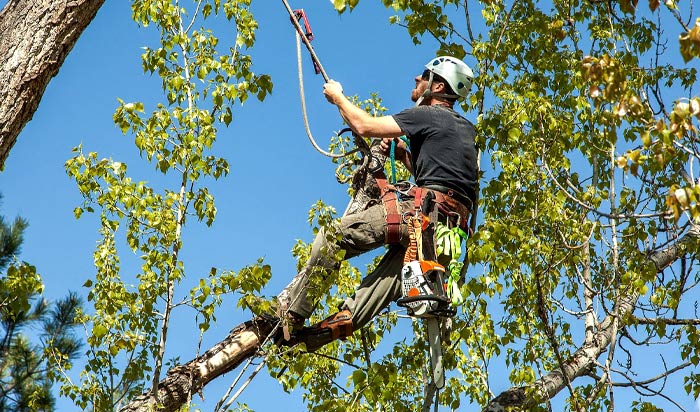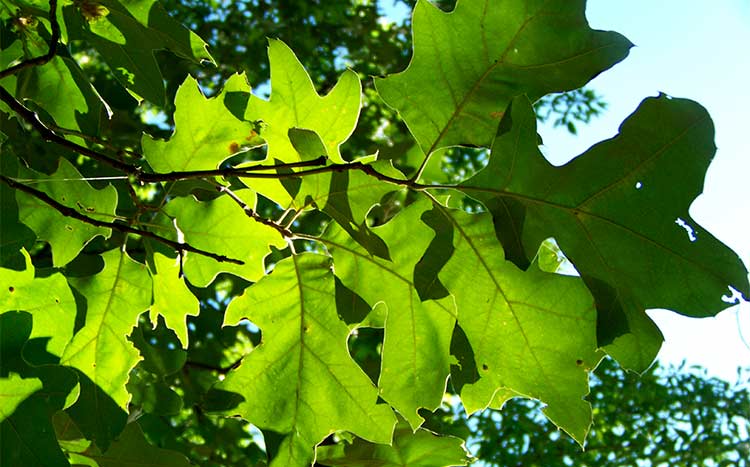While most types of trees are not sensitive to the timing of a trim, oak trees. In fact, if you trim your oak tree during the wrong season, it can end up dying. Therefore, if you own an oak tree, knowing not only how to properly trim the tree, but also when to trim it, is essential.
An oak tree should be trimmed during winter. This is so because trimming it during other seasons, like summer, leaves it vulnerable to oak wilt. This is a disease that is spread by bugs that feed on the oak’s sap. And once this disease invades the tree through the open wounds caused by trimming cuts, it can kill the oak tree. Therefore, restricting your trimming activities to winter is generally advisable when it comes to oak trees.
Here is what you should know about trimming oak trees.
Although winter is the perfect time to trim oak trees, it is still ok to trim them during fall. However, if you have to do it during fall, it has to be late fall and not early fall. This is because, in late fall, the harmful organisms that are responsible for causing oak wilt aren’t as active. As a result, you can get away with trimming the tree without exposing it to the risk of this dangerous disease.

What about in summer?
Summer is the worst time to trim an oak tree. This is because, during summer, the pests that are responsible for oak wilt are usually active.
Therefore, when you trim your oak tree during this period, they will be drawn to your tree by the sap on the exposed tree wounds. They will eventually infect your tree with this disease, and this may eventually end up killing it.
How often should oak trees be trimmed?
It is advisable to trim oak trees after every 2 years to 5 years. Generally, a young oak tree will need to be trimmed more regularly than a fully-grown oak tree. For the young ones, trimming them after every 2 or 3 years is ideal. And as for the mature ones, an interval of between 3 to 5 years is what is recommended.
Do I need a permit to trim an oak tree?
Yes, in most cases, you will need a permit in order to trim an oak tree. This is mainly because oak trees tend to feature on most cities’ lists of significant trees. And a permit is especially required if the tree is large in size, older, or if it is in great condition.
However, a permit is not always mandatory. There are certain circumstances under which you may not be required to have a permit before trimming an oak tree.
The most common exception has to do with the tree being a hazard to the public. In cases where it seems like its branches may fall off and injure people or damage property, you may be allowed to trim it without any permit. However, in most jurisdictions, you will have to file a report detailing the reason for the action and describing the condition of the tree.
Since not all local jurisdictions include oak trees in their lists of significant trees, some may not make it mandatory to seek a permit before trimming. You may also not need a permit in case the oak tree is really young or small in size.

How much does tree trimming cost?
On average, tall trees like oaks cost between $250 and $1,000 to trim. Trees that are shorter — less than 30 feet in height — may cost as little as $175, while those that fall between 30 feet and 60 feet may cost up to $1,875.
However, the actual amount that you end up spending on trimming a tree will depend on its size, how easy it is to access, whether it is near utilities like power lines, and even the type of tree. Whether you choose to trim it yourself or to hire a professional tree trimmer will also play a significant role in determining how much you will end up spending on tree trimming.
Should I hire a pro arborist?
Yes, it is always advisable to hire a pro arborist when you have to trim tall trees or trees that are as season-sensitive as oaks.
Hire an arborist to guarantee better-trimming results and tree health
Arborists tend to have the training, expertise, and experience necessary to ensure that they trim the tree without injuring it. As a result, opting to hire an arborist could be the difference between your tree surviving or dying.
However, the prudence in hiring an arborist doesn’t always lie in guaranteeing your tree’s health. When it comes to large trees, it is sometimes a matter of safety.
Hire an arborist to avoid personal injury and property damage
Trimming a tree can be dangerous and in some cases, it has proven to be fatal. The risks of injury range from using heavy machinery, falling from heights, and even electrocution. There are also cases where large branches or sometimes even trees fall on trimmers and passersby. There is also the risk of property damage.
Therefore, while it is possible to save money by trimming a tree on your own, it is always a good idea to let a qualified arborist handle this part of the tree care routine.
Use this free service
The easiest way to receive tree-trimming help from someone who knows what they are doing is to use GoTreeQuotes.com. It offers a free service that quickly matches you with the top-voted local tree experts in your area.
Using the website, you can get 3 estimates fast by real certified experts in your area in just 2 minutes. Here is how it works.
- You scroll to the top of the page and enter your Zip code.
- Answer questions about your tree care needs
- Your details will be forwarded to three local experts.
- You will then receive a price estimate for the job and some friendly advice.
IMPORTANT: There is no obligation to hire. This is a free tool and service to be used at your pleasure.

What should I put on the wound after pruning?
Immediately after pruning an oak tree, you should seal all of its wounds with black paint or a pruning seal. Doing so will help to protect your tree from oak wilt.
The sealant will keep wood-boring beetles from feeding on the oak tree’s sap, and since they are the ones that are responsible for most cases of oak wilt, this will keep your tree from suffering the devastating effects of this dangerous disease.
FAQ's
Yes, topping a tree is bad. This is because when you top a tree, you subject it to severe trauma that is sometimes too extreme for the tree to recover from.
For starters, you rob the tree of the foliage that it usually uses to produce food. Therefore, you will be putting your tree at risk of starvation. And if the tree doesn’t adapt quickly enough by developing water sprouts and enough leaves to make up for the lost foliage, it can even starve to death.
The other reason why it is bad is that you will be exposing the tree to diseases and rotting. The open wounds that you create as a result of topping will be a major draw for disease-spreading pests, insects, and rotting agents. They will not only have a negative effect on the tree’s health but can even go as far as killing it.
It is also bad from an aesthetic appeal perspective. Simply hacking off a tree’s beautiful crown will rob it of its beauty. And if it is on your property, the practice can even lower your property’s value.
Yes, you can over-trim a tree. This typically happens when one doesn’t have a proper pruning plan or when one fails to follow the recommended pruning steps.
It normally occurs when in the course of pruning, one ends up cutting off more than 25% of the tree’s crown. In such a case, you will be robbing the tree of a significant part of its food-producing resource. You will also be creating a lot of wounds through the cuts that you make, and this can expose the tree to rotting and pest infestation. The chances of the tree losing its beauty will also be high.
Generally, you tip a tree service between 15% to 25% of the total cost of the project. However, if several laborers are working on your trees, then giving each a tip of between $10 to $20 will be more prudent.
These are the main things that you should keep in mind when trimming oak trees. Other tips like making sure that your trimming tools are properly cleaned and sharpened before using them, will also help to ensure that your trees are healthy and pest-free after giving them a trim.











